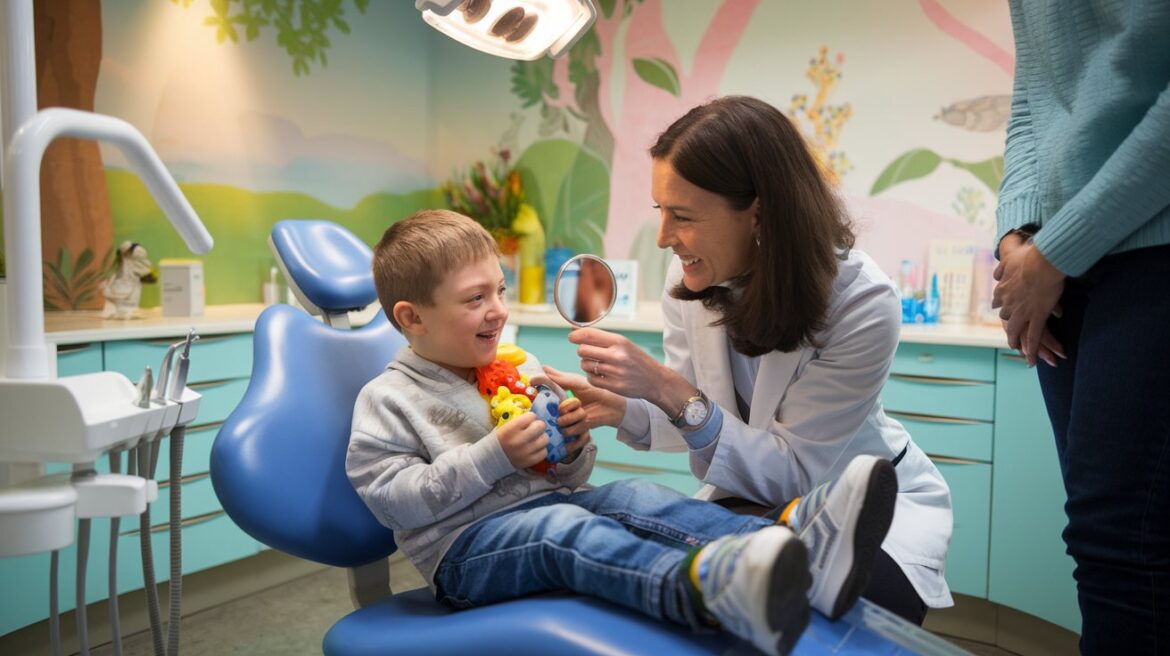Pain Less Dental Experience for Special Needs Child
Dental visits can be overwhelming for children, but they can be particularly challenging for those with special needs. These children often require specialized care, understanding, and preparation to ensure a positive, stress-free experience. This detailed guide breaks down each aspect of how parents, caregivers, and dental professionals can work together to make dental visits comfortable and painless for special needs children.
1. Understanding the Unique Needs of a Special Needs Child:
Children with special needs may have a variety of physical, developmental, sensory, or behavioral conditions that impact their dental care experience. It’s important to acknowledge the uniqueness of each child and how their specific needs should be considered during dental visits. Common conditions may include:
- Autism Spectrum Disorder (ASD): Children with ASD may be sensitive to bright lights, loud noises, and unfamiliar environments. They may have difficulty communicating their discomfort or needs.
- Down Syndrome: Children with Down syndrome may have specific dental issues such as delayed tooth eruption, misaligned teeth, or gum disease, which require additional attention.
- ADHD: Attention-deficit/hyperactivity disorder can make it difficult for children to sit still for long periods, leading to increased anxiety and difficulty cooperating.
- Sensory Processing Disorder (SPD): Children with SPD may be hypersensitive to the sensations associated with dental care, such as vibrations, sounds, and smells.
- Physical Disabilities: Mobility or muscle control issues can make it difficult for children with physical disabilities to maintain proper oral hygiene or remain comfortable in a dental chair.
Each of these conditions presents unique challenges. Dental professionals must adopt specialized approaches to meet the specific needs of the child and ensure a comfortable experience.
2. Choosing the Right Dentist:
Finding a dentist who specializes in caring for special needs children is critical. Many pediatric dentists undergo additional training to provide care for children with physical or developmental challenges. These specialists are skilled at adjusting their approach, from the way they communicate with the child to how they perform dental procedures. Look for a dental office that offers:
- A calm and sensory-friendly environment.
- Staff who are patient, understanding, and experienced in handling different behavioral needs.
- Adapted equipment, such as quieter tools or child-friendly seating arrangements, may be less intimidating to a special needs child.
A skilled dentist will ensure the experience is less frightening and more comfortable for both the child and their caregivers.
3. Pre-Visit Preparation:
Preparing for a dental visit is a crucial step in creating a painless and stress-free experience for a special needs child. Parents and caregivers can work closely with the dentist to ensure the child is adequately prepared before the visit.
Communicating with the Dentist: Before the first appointment, communicate the child’s condition and specific needs. Provide detailed information, such as:
- Sensory sensitivities (e.g., aversion to certain sounds, lights, or textures).
- Behavioral triggers (e.g., fear of strangers or unfamiliar situations).
- Any medications or medical devices the child may use.
- Techniques or strategies that have worked in other medical settings, such as distraction techniques or rewards for positive behavior.
Pre-Visit Tours: Many dentists offer pre-visit tours, allowing the child to become familiar with the office environment without undergoing any procedures. These tours can help alleviate anxiety, as the child will have the opportunity to meet the dentist and staff, see the dental chair, and explore the office at their own pace.
Using Visual Aids and Social Stories: Using visual aids such as picture books or videos that explain dental procedures in a child-friendly way can reduce fear. Social stories—short, illustrated narratives—can be helpful for children with ASD or communication challenges. These stories outline what to expect during a dental visit, providing a clear and simple explanation that the child can easily follow.
4. Familiarization at Home:
Before the dental appointment, parents can help their child get accustomed to some of the sensations and tools they might encounter during the visit.
Practicing at Home: Parents can simulate a dental visit at home by:
- Have the child practice opening their mouth wide while looking in the mirror.
- Introducing a toothbrush or other small dental instruments, like a tongue depressor, to familiarize the child with the sensation of something in their mouth.
- Using an electric toothbrush to mimic the vibrations of dental tools.
These activities help desensitize the child to the sensations they will experience, making the actual dental procedure less intimidating.
5. Sedation Options for a Painless Experience:
For children who experience significant anxiety or who may be unable to sit still for extended periods, sedation is often a safe and effective option to ensure a painless dental experience. Different levels of sedation are available, depending on the child’s needs and the complexity of the procedure.
Nitrous Oxide (Laughing Gas): Nitrous oxide is a mild sedative that helps calm the child while allowing them to remain conscious. It is administered through a mask, and its effects wear off quickly after the procedure. This option is ideal for children with mild anxiety or who need help relaxing during a routine visit.
Oral Sedation: Oral sedation involves giving the child a liquid medication that induces relaxation and reduces anxiety before the procedure. The child remains conscious but may feel drowsy or less aware of their surroundings. This is often used for more anxious children or those undergoing longer procedures.
General Anesthesia: For children with severe behavioral issues, extreme anxiety, or extensive dental needs, general anesthesia may be recommended. Under general anesthesia, the child is completely asleep and unaware of the procedure. This method ensures the child experiences no discomfort or pain but is typically reserved for more complex cases due to its higher risks and longer recovery period.
6. Desensitization and Behavioral Techniques:
Behavioral strategies can help ease the child’s fears and improve cooperation over time. Pediatric dentists use techniques like desensitization, which involves gradually introducing the child to dental procedures in small, manageable steps. The child may begin with non-invasive tasks, such as having their teeth counted or holding a dental mirror, before progressing to more advanced procedures.
Positive Reinforcement: Rewarding positive behavior is a critical component of desensitization. Dentists may use praise, stickers, or small toys to reward the child for each step completed during the visit. Over time, this builds trust and confidence, helping the child associate dental visits with positive experiences.
7. Sensory-Sensitive Tools and Techniques:
Children with sensory processing issues may find traditional dental tools overwhelming. Many dental offices accommodate these needs with sensory-friendly tools, such as quieter drills or instruments that produce fewer vibrations. Other sensory adaptations might include:
- Noise-canceling headphones to block out the sound of dental equipment.
- Weighted blankets to provide calming pressure and reduce anxiety during the procedure.
- Sunglasses to shield the child’s eyes from bright lights in the dental chair.
These small adjustments can significantly improve the child’s comfort level during the visit.
8. Post-Visit Care and Recovery:
After the dental visit, it’s essential to offer comfort and reassurance to the child, especially if sedation is used. Depending on the sedation method, the child may feel groggy or disoriented, so caregivers should monitor them closely as they recover. Encourage the child to rest, drink plenty of fluids, and avoid strenuous activities for the remainder of the day.
Celebrating Success: Even if only minor steps were completed during the dental visit, it’s important to celebrate the child’s bravery and accomplishments. Positive reinforcement helps build confidence for future visits and reduces fear over time.
9. Long-Term Dental Care Strategies:
Routine dental care is especially important for special needs children, as they may be at higher risk for oral health issues. Developing a long-term dental care plan includes:
- Establishing a daily oral hygiene routine at home, using adaptive toothbrushes or flossing aids as necessary.
- Scheduling regular dental check-ups with a dentist experienced in special needs care.
- Preventive treatments like fluoride applications or sealants to prevent cavities and other dental problems.
By building a positive relationship with the dentist and maintaining good oral hygiene practices, long-term dental health can be ensured without fear or pain.
Creating a painless dental experience for a special needs child is achievable with the right preparation, care, and collaboration between caregivers and dental professionals. By understanding the child’s unique needs, using sedation options, applying sensory-sensitive tools, and employing behavioral techniques, dental visits can become less stressful and more comfortable. With these strategies, every special needs child can receive the essential dental care they need, free from fear and pain.








